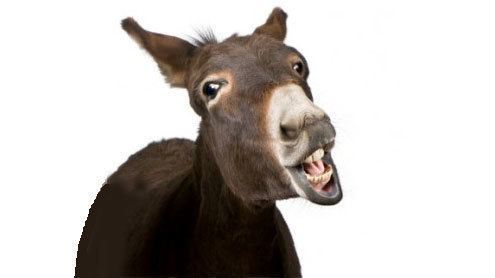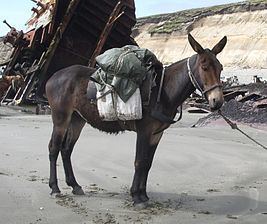Mass 23 – 450 kg Rank Hybrid | ||
 | ||
Scientific name Equus asinus × Equus caballus Similar Hinny, Donkey, Liger | ||
Ponies horses donkeys mules everything you need to know
A mule is the offspring of a male donkey (jack) and a female horse (mare). Horses and donkeys are different species, with different numbers of chromosomes. Of the two F1 hybrids (first generation hybrids) between these two species, a mule is easier to obtain than a Hinny, which is the offspring of a female donkey (jenny) and a male horse (stallion).
Contents
- Ponies horses donkeys mules everything you need to know
- My mule is really mad
- Biology
- Characteristics
- Color and size variety
- Distribution and use
- Fertility
- Modern mules
- Mule train
- Mule clone
- References

The size of a mule and work to which it is put depend largely on the breeding of the mule's female parent (dam). Mules can be lightweight, medium weight, or when produced from draft horse mares, of moderately heavy weight. Mules are more patient, hardy and long-lived than horses, and are less obstinate and more intelligent than donkeys.

My mule is really mad
Biology
The mule is valued because, while it has the size and ground-covering ability of its dam, it is stronger than a horse of similar size and inherits the endurance and disposition of the donkey sire, tending to require less food than a horse of similar size. Mules also tend to be more independent than most domesticated equines other than the donkey.

The median weight range for a mule is between about 370 and 460 kg (820 and 1,000 lb). While a few mules can carry live weight up to 160 kg (353 lb), the superiority of the mule becomes apparent in their additional endurance.

In general, a mule can be packed with dead weight of up to 20% of its body weight, or approximately 90 kg (198 lb). Although it depends on the individual animal, it has been reported that mules trained by the Army of Pakistan can carry up to 72 kilograms (159 lb) and walk 26 kilometres (16.2 mi) without resting. The average equine in general can carry up to approximately 30% of its body weight in live weight, such as a rider.
A female mule that has estrus cycles and thus, in theory, could carry a fetus, is called a "molly" or "Molly mule", though the term is sometimes used to refer to female mules in general. Pregnancy is rare, but can occasionally occur naturally as well as through embryo transfer. A male mule is properly called a horse mule, though often called a john mule, which is the correct term for a gelded mule. A young male mule is called a mule colt, and a young female is called a mule filly.
Characteristics
With its short thick head, long ears, thin limbs, small narrow hooves, and short mane, the mule shares characteristics of a donkey. In height and body, shape of neck and rump, uniformity of coat, and teeth, it appears horse-like. The mule comes in all sizes, shapes and conformations. There are mules that resemble huge draft horses, sturdy quarter horses, fine-boned racing horses, shaggy ponies and more.
The mule is an example of hybrid vigor. Charles Darwin wrote: "The mule always appears to me a most surprising animal. That a hybrid should possess more reason, memory, obstinacy, social affection, powers of muscular endurance, and length of life, than either of its parents, seems to indicate that art has here outdone nature."
The mule inherits from its sire the traits of intelligence, sure-footedness, toughness, endurance, disposition, and natural cautiousness. From its dam it inherits speed, conformation, and agility. Mules exhibit a higher cognitive intelligence than their parent species. This is also believed to be the result of hybrid vigor, similar to how mules acquire greater height and endurance than either parent.
Handlers of working animals generally find mules preferable to horses: mules show more patience under the pressure of heavy weights, and their skin is harder and less sensitive than that of horses, rendering them more capable of resisting sun and rain. Their hooves are harder than horses', and they show a natural resistance to disease and insects. Many North American farmers with clay soil found mules superior as plow animals.
A mule does not sound exactly like a donkey or a horse. Instead, a mule makes a sound that is similar to a donkey's but also has the whinnying characteristics of a horse (often starts with a whinny, ends in a hee-haw). Mules sometimes whimper.
Color and size variety
Mules come in a variety of shapes, sizes and colors, from minis under 50 lb (23 kg) to maxis over 1,000 lb (454 kg), and in many different colors. The coats of mules come in the same varieties as those of horses. Common colors are sorrel, bay, black, and grey. Less common are white, roans (both blue and red), palomino, dun, and buckskin. Least common are paint mules or tobianos. Mules from Appaloosa mares produce wildly colored mules, much like their Appaloosa horse relatives, but with even wilder skewed colors. The Appaloosa color is produced by a complex of genes known as the Leopard complex (Lp). Mares homozygous for the Lp gene bred to any color donkey will produce a spotted mule.
Distribution and use
Mules historically were used by armies to transport supplies, occasionally as mobile firing platforms for smaller cannons, and to pull heavier field guns with wheels over mountainous trails such as in Afghanistan during the Second Anglo-Afghan War.
The Food and Agriculture Organization of the United Nations (FAO) reports that China was the top market for mules in 2003, closely followed by Mexico and many Central and South American nations.
Fertility
Mules and hinnies have 63 chromosomes, a mixture of the horse's 64 and the donkey's 62. The different structure and number usually prevents the chromosomes from pairing up properly and creating successful embryos, rendering most mules infertile.
There are no recorded cases of fertile mule stallions. A few mare mules have produced offspring when mated with a purebred horse or donkey. Herodotus gives an account of such an event as an ill omen of Xerxes' invasion of Greece in 480 BC: "There happened also a portent of another kind while he was still at Sardis,—a mule brought forth young and gave birth to a mule" (Herodotus The Histories 7:57), and a mule's giving birth was a frequently recorded portent in antiquity, although scientific writers also doubted whether the thing was really possible (see e.g. Aristotle, Historia animalium, 6.24; Varro, De re rustica, 2.1.28).
As of October 2002, there had been only 60 documented cases of mules birthing foals since 1527. In China in 2001, a mare mule produced a filly. In Morocco in early 2002 and Colorado in 2007, mare mules produced colts. Blood and hair samples from the Colorado birth verified that the mother was indeed a mule and the foal was indeed her offspring.
A 1939 article in the Journal of Heredity describes two offspring of a fertile mare mule named "Old Bec", which was owned at the time by the A&M College of Texas (now Texas A&M University) in the late 1920s. One of the foals was a female, sired by a jack. Unlike its mother, it was sterile. The other, sired by a five-gaited Saddlebred stallion, exhibited no characteristics of any donkey. That horse, a stallion, was bred to several mares, which gave birth to live foals that showed no characteristics of the donkey.
Modern mules
In the second half of the 20th century, widespread usage of mules declined in industrialized countries. The use of mules for farming and transportation of agricultural products largely gave way to modern tractors and trucks. However, in the United States, a dedicated number of mule breeders continued the tradition as a hobby and continued breeding the great lines of American Mammoth Jacks started in the United States by George Washington with the gift from the King of Spain of two Zamorano-Leonés donkeys. These hobby breeders began to utilize better mares for mule production until today's modern Saddle mule emerged. Exhibition shows where mules pulled heavy loads have now been joined with mules competing in Western and English pleasure riding, as well as dressage and show jumping competition. There is now a cable TV show dedicated to the training of donkeys and mules. Mules, once snubbed at traditional horse shows, have been accepted for competition at the most exclusive horse shows in the world in all disciplines.
Mules are still used extensively to transport cargo in rugged roadless regions, such as the large wilderness areas of California's Sierra Nevada mountains or the Pasayten Wilderness of northern Washington state. Commercial pack mules are used recreationally, such as to supply mountaineering base camps, and also to supply trail building and maintenance crews, and backcountry footbridge building crews. As of July 2014, there are at least sixteen commercial mule pack stations in business in the Sierra Nevada. The Angeles chapter of the Sierra Club has a Mule Pack Section that organizes hiking trips with supplies carried by mules.
Amish farmers, who reject tractors and most other modern technology for religious reasons, commonly use teams of six or eight mules to pull plows, disk harrows, and other farm equipment, though they use horses for pulling buggies on the road.
During the Soviet war in Afghanistan, the United States used large numbers of mules to carry weapons and supplies over Afghanistan's rugged terrain to the mujahideen. Use of mules by U.S. forces has continued during the War in Afghanistan (2001-present), and the United States Marine Corps has conducted an 11-day Animal Packers Course since the 1960s at its Mountain Warfare Training Center located in the Sierra Nevada near Bridgeport, California.
Mule train
A mule train is a connected or unconnected line of pack mules, usually carrying cargo. Because of the mule's ability to carry as much as a horse, their trait of being sure footed along with their tolerance of poorer coarser foods and abilities to tolerate arid terrains, mule trains were common caravan organized means of animal powered bulk transport back into pre-classical times. In many climate and circumstantial instances, an equivalent string of pack horses would have to carry more fodder and sacks of high energy grains such as oats, so could carry less cargo. In modern times, strings of sure footed mules have been used to carry riders in dangerous but scenic back country terrain such as excursions into canyons.
Pack trains were instrumental in opening up the American West as the sure footed animals could carry up to 250 pounds, survive on rough forage, did not require feed, and could operate in the arid higher elevations of the Rockies, serving as the main cargo means to the west from Missouri during the heyday of the North American fur trade. Their use antedated the move west into the Rockies as colonial Americans sent out the first fur trappers and explorers past the Appalachians who were then followed west by high-risk-taking settlers by the 1750s (such as Daniel Boone) who led an increasing flood of emigrants that began pushing west over the into southern New York, and through the gaps of the Allegheny into the Ohio Country (the lands of western Province of Virginia and the Province of Pennsylvania), into Tennessee and Kentucky before and especially after the American Revolution.
Mule trains have been used as working (as opposed to tourist attractions) portions of transportation links as recently as 2005 by the World Food Programme.
In the nineteenth century, twenty-mule teams, for instance, were teams of eighteen mules and two horses attached to large wagons that ferried borax out of Death Valley from 1883 to 1889. The wagons were among the largest ever pulled by draft animals, designed to carry 10 short tons (9 metric tons) of borax ore at a time.
Mule clone
In 2003, researchers at University of Idaho and Utah State University produced the first mule clone as part of Project Idaho. The research team included Gordon Woods, professor of animal and veterinary science at the University of Idaho; Kenneth L. White, Utah State University professor of animal science; and Dirk Vanderwall, University of Idaho assistant professor of animal and veterinary science. The baby mule, Idaho Gem, was born May 4. It was the first clone of a hybrid animal. Veterinary examinations of the foal and its surrogate mother showed them to be in good health soon after birth. The foal's DNA comes from a fetal cell culture first established in 1998 at the University of Idaho.
